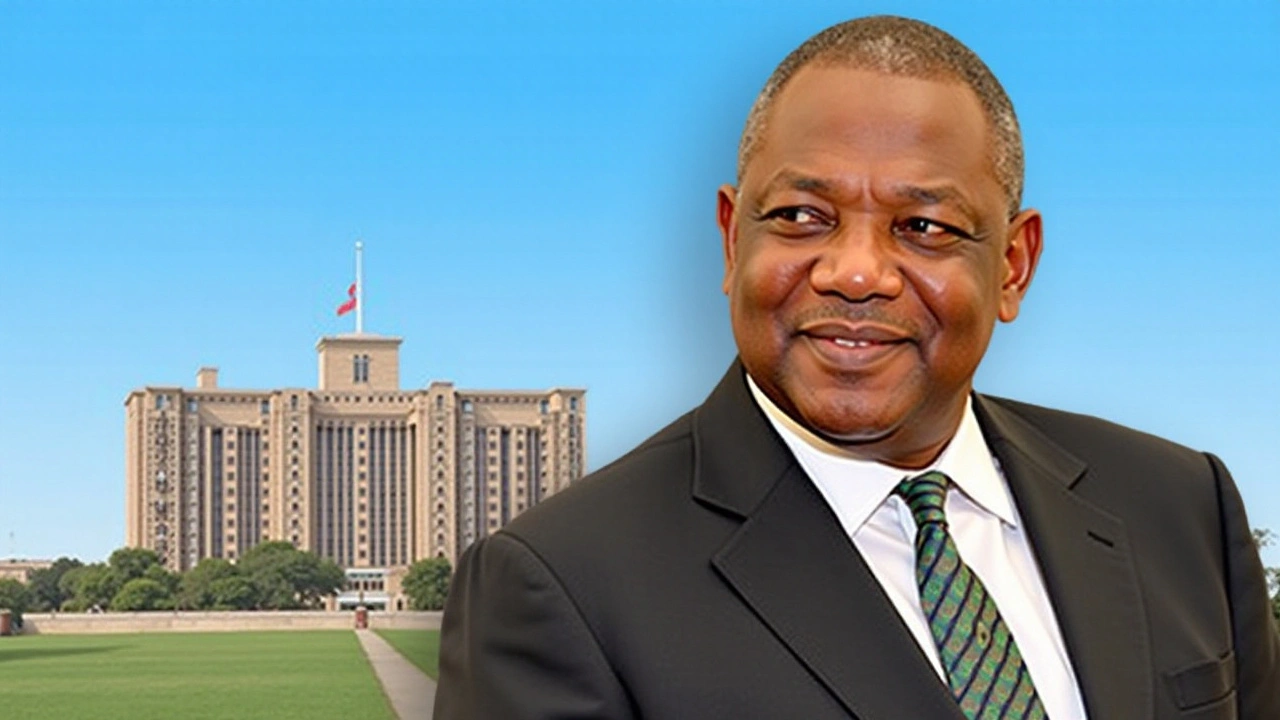South Africa's Inflation Rate Declines, Raising Hopes for Interest Rate Reductions
In a significant economic development, South Africa's consumer inflation rate has eased to 4.4% in August, down from 4.6% in July. This marks the lowest level in more than three years, offering a glimmer of hope for potential interest rate cuts. Such a reduction could provide much-needed relief to borrowers and spur economic growth. Lower inflation generally translates into lower interest rates since central banks use rate changes as a tool to manage inflation and economic stability. Hence, this recent dip is seen as a positive indicator.
The reduction in inflation has been attributed to decreased prices in specific sectors. For instance, food prices, which often dominate discussions on inflation in South Africa, have shown a reduction. The same trend has been observed in the prices of certain goods and services, contributing to the overall decline. This drop can bring a breath of fresh air to the economy, encouraging consumer spending and investment, as borrowing costs could potentially decrease if the central bank decides to cut interest rates. This interplay between inflation and interest rates is crucial in driving a healthier economic environment.
Impact on Economic Growth
The lower inflation rate is a positive sign for economic growth. When inflation is high, the cost of living increases, leading to less disposable income for consumers. High inflation also erodes purchasing power, making it more expensive for individuals and businesses to borrow money. However, with inflation rates dropping, there is a possibility of reduced interest rates, indirectly boosting economic activities by making loans and mortgages more affordable.
Moreover, a decline in inflation can also stabilize the currency, in South Africa's case, the rand. A stable currency can attract foreign investment, as it reduces the risk for investors. This could lead to increased capital inflows, further supporting the economy. However, while the immediate outlook appears promising, caution remains essential. Economic challenges such as unemployment, inequality, and policy uncertainty can't be overlooked and could still affect inflationary trends.
Factors Influencing the Decline
Several factors have contributed to this decrease in inflation. Cost reductions in the energy sector and a more solid agricultural output have played a part. South Africa's energy sector, notorious for its price volatility, saw more stable conditions recently. Moreover, favorable weather patterns and improved farming practices have led to an increase in agricultural yield, reducing food prices.
Transportation costs have also seen a decline, contributing to the overall reduction. Lower fuel prices in recent months have had a trickle-down effect, making logistics and thus goods' prices cheaper. However, it's important to note that these factors are not permanently assured. Fluctuations in global oil prices and potential adverse weather conditions could alter this dynamic swiftly.
Challenges and Future Projections
Despite the promising signs, economists urge caution in predicting a future of sustained low inflation. The global economic landscape remains fraught with uncertainties, including trade tensions, fluctuating commodity prices, and geopolitical developments. Additionally, domestic issues such as policy unpredictability and structural weaknesses continue to pose significant challenges.
For instance, though there has been a dip in inflation, the permanent solution to quelling inflationary pressures lies in addressing these structural challenges. Effective governance, employment generation, and ensuring policy clarity are vital. The broader economic recovery process necessitates substantial and persistent efforts on various fronts.
The Role of the Central Bank
Now, all eyes are on the South African Reserve Bank (SARB). The central bank has been cautious in adjusting interest rates amid inflation concerns. This latest data instigates speculation about a possible rate cut. Monetary policy is a delicate balancing act; while reducing rates can stimulate growth, it must ensure inflation remains within manageable limits. Thus, the SARB's forthcoming decisions will be pivotal.
The central bank's primary mandate is to maintain price stability, and with inflation inching closer to their target range, there is a justified case for policy relaxation. However, making such a decision is not straightforward. It requires a comprehensive assessment of all economic variables - from consumer confidence to global economic conditions. Therefore, the decision, while eagerly anticipated, must be carefully weighed.

Conclusion
In summary, the drop in South Africa's consumer inflation rate to 4.4% is a beacon of optimism amidst a sea of economic challenges. It has the potential to pave the way for reduced interest rates, boosting borrowing, spending, and investment. The positive trend, driven by lowered costs in key sectors like energy, food, and transportation, indeed marks a step toward economic recovery. However, caution is still warranted given the persistent challenges on both domestic and international fronts.
The journey to sustained economic stability involves addressing structural issues and ensuring a robust policy framework. How the central bank navigates this terrain remains crucial. As we look to the future, informed and balanced economic policies will be vital in steering South Africa toward a more stable and prosperous horizon.







Joseph Conlon
While the headline sings praises about a deceleration in inflation, it's worth remembering that South Africa's economy has been a roller coaster of policy missteps for years. The 4.4% figure sounds like a sigh of relief, but it's still above the central bank's target range and hardly a victory lap. Historically, such modest dips have been reversed as soon as global commodity prices wobble, which they inevitably do. Moreover, the reliance on temporary factors like a good harvest or lower fuel costs is a fragile foundation for any monetary easing. Even if the Reserve Bank were to trim rates, the structural issues-unemployment, inequality, and fiscal deficits-remain untouched. A rate cut might provide a short-lived boost to borrowing, but without real growth, it could just inflate asset bubbles. The Rand's stability, touted as a side effect, is also subject to external shocks that South Africa cannot control. In the end, the headline numbers are only a snapshot, not a guarantee of lasting prosperity. Look beyond the stats and ask whether the underlying economic policies are shifting in the right direction. If not, this dip might be a mirage that evaporates with the next oil price surge or a drought‑induced crop shortfall. So, while optimism is understandable, a cautious stance remains the prudent path.
Mohit Singh
Honestly, this so‑called “good news” feels like a band‑aid on a broken leg. Lower inflation today doesn’t magically fix the massive debt pile or the massive brain drain. If the SARB thinks a tiny rate cut will solve everything, they’re deluding themselves. The global market is volatile, and South Africa will get hit again before you know it.
Damian Liszkiewicz
Hey folks, happy to see some light at the end of the tunnel 😃. A dip in inflation is like a breath of fresh air after a long smoggy day. It gives us a chance to reflect on how interconnected our policies, weather patterns, and global oil prices really are. Let’s celebrate the progress, but also stay vigilant – the economy is a delicate ecosystem that needs careful nurturing 🌱.
Angela Arribas
Interesting read, but the article seems to gloss over some basic grammar – “the reduction can bring a breath of fresh air to the economy” should be “brings”. Also, celebrating a modest dip without addressing the structural problems feels a bit naive. :)
Sienna Ficken
Well, slap my knee and call me a skeptic – 4.4%? That’s barely a dent in the wall of doom that’s been looming. If you think a slight dip is the harbinger of a golden era, you must be sipping some kale‑infused optimism smoothie. The real story is the people still struggling to put food on the table, not these fancy percentages.
Zac Death
Points well taken. While a modest drop in inflation can lift spirits, we have to keep an eye on the bigger picture. Sustainable growth requires more than a quick rate tweak; it needs policy consistency, investment in skills, and a stable regulatory environment. Let’s stay hopeful but realistic.
Lizzie Fournier
Just a reminder that even with lower inflation, households still face high living costs. It's a mixed bag – some relief, but not the full solution.
JAN SAE
Absolutely! This is a good moment to celebrate the progress!!! But remember, the work is far from over!!! Keep the dialogue going and stay engaged!!!
Steve Dunkerley
From a macro‑economic perspective, the decline in CPI illustrates the elastic nature of consumer price indices under exogenous shocks. Nevertheless, the structural supply‑side constraints persist, warranting a nuanced policy response rather than a unilateral rate cut.
Jasmine Hinds
Cool news! 😊
Madison Neal
I appreciate the optimism, yet we must recognize the deep-rooted challenges that still loom over the economy. The dip is a positive indicator but not a panacea.
John Crulz
Do you think this will actually translate to lower mortgage rates soon? It would be great for first‑time buyers.
Anita Drake
From a cultural standpoint, it’s encouraging to see economic data moving in a positive direction; it can boost national morale.
Eduardo Lopez
While the data appears promising, let’s not be swept away by melodrama. A measured approach from the central bank will serve the nation best.
Nancy Perez de Lezama
It is noteworthy that the inflation drop coincides with a relatively stable rand, which could attract further investment.
Matt Heitz
We must remain vigilant; any premature easing could fuel inflationary expectations, jeopardizing long‑term stability. The central bank should prioritize data‑driven decisions over political pressure.
Susan Mark
Great to see some good news! Let’s hope it helps everyday people feel a bit of relief.
Jason Jennings
Well, if they cut rates too soon, we’ll just end up with another round of price hikes. Better wait and see.
Diego Vargas
Honestly the numbers dont lie, but the story behind them is more complicated than a simple headline. People still need jobs and stability.